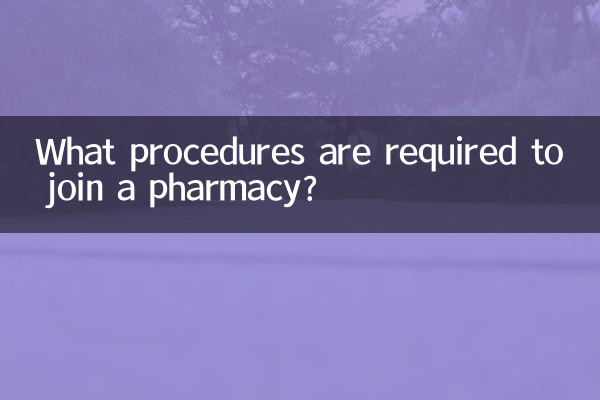What procedures are required to join a pharmacy?
In recent years, with the rapid development of the pharmaceutical industry, franchising pharmacies has become the choice of many entrepreneurs. However, franchised pharmacies need to go through a series of procedures to ensure legal and compliant operations. This article will introduce you in detail to the various procedures required to join a pharmacy and provide structured data to help you quickly understand the process.
1. Basic conditions for joining a pharmacy

Before applying to join a pharmacy, you need to meet the following basic conditions:
| condition | Specific requirements |
|---|---|
| Qualification requirements | Possess a "Drug Business License" or cooperate with a qualified chain pharmacy |
| Business premises | Comply with area, layout and facility requirements specified by local drug regulatory authorities |
| Staffing | At least one licensed pharmacist is required, and other employees must receive professional training. |
| Funding requirements | Have sufficient start-up capital, including franchise fees, decoration fees, purchase fees, etc. |
2. Main procedures for joining a pharmacy
There are many procedures required to join a pharmacy. The following are the main steps:
| step | Specific content |
|---|---|
| 1. Choose a franchise brand | Investigate multiple drugstore chain brands and choose one with good reputation and strong support. |
| 2. Sign a franchise contract | Sign a franchise agreement with the brand to clarify the rights and obligations of both parties |
| 3. Apply for a business license | Apply to the local industrial and commercial department for an individual business or company business license |
| 4. Apply for a drug business license | Submit application materials to the local drug regulatory department and pass on-site inspection |
| 5. Apply for GSP certification | Passed GSP certification in accordance with the requirements of "Good Manufacturing Practices for Pharmaceutical Products" |
| 6. Tax registration | Go through tax registration at the tax department and obtain a tax registration certificate |
| 7. Other filings | Apply for medical device business registration, food business license, etc. as needed |
3. Drug business license application materials
Applying for a drug business license is a key step in joining a pharmacy. The following is a list of required materials:
| Material name | Remarks |
|---|---|
| Drug business license application form | Requires company seal |
| Copy of business license | Requires company seal |
| Proof of identity of legal representative | Copy of ID card |
| Licensed Pharmacist Qualification Certificate | Original and copy |
| Proof of business premises | Real estate certificate or lease contract |
| Quality management system documents | Including drug procurement, acceptance, storage and other systems |
| Other related materials | Available according to local requirements |
4. Things to note when joining a pharmacy
When joining a pharmacy, you need to pay attention to the following matters:
1.Site selection requirements: The location of a pharmacy should comply with local planning requirements, which generally require a certain distance from hospitals, schools and other places.
2.Brand selection: When choosing a franchise brand, you should examine its comprehensive strength such as market reputation, supply system, and training support.
3.capital budget: Franchising a pharmacy requires a large investment. In addition to the franchise fee, you also need to consider the costs of decoration, equipment, first batch of goods, etc.
4.professionals: It is necessary to have a licensed pharmacist and ensure that he or she can be on duty full-time. This is the focus of inspection by the drug regulatory authorities.
5.Compliance management: Strictly abide by drug management regulations, and are not allowed to sell fake or inferior drugs. Prescription drugs must be sold with a prescription.
5. Advantages and risks of franchising pharmacies
Franchise pharmacies have the following advantages:
| Advantages | illustrate |
|---|---|
| brand effect | Leverage existing brand awareness to quickly gain consumer trust |
| Unified supply | The headquarters provides stable drug supply channels to ensure drug quality |
| Management support | Obtain operational management guidance and training support from the headquarters |
| Marketing support | Share marketing resources and promotions from headquarters |
At the same time, there are certain risks involved in joining a pharmacy:
| risk | illustrate |
|---|---|
| High franchise fee | Some well-known brands have higher franchise fees and deposits |
| operating restrictions | Must abide by the unified management of the headquarters and have limited independent operating rights |
| Market competition is fierce | There are a large number of pharmacies and serious homogeneous competition. |
| policy risk | Changes in pharmaceutical policies may affect operations |
6. Summary
Franchising a pharmacy is an entrepreneurial project that needs to be treated with caution. Although the procedures are relatively complicated, legal and compliant operations can be ensured through formal channels. It is recommended to fully understand the market conditions before joining, choose a reliable franchise brand, and reserve sufficient funds and time to complete various procedures. At the same time, we must continue to pay attention to policy changes in the pharmaceutical industry and adjust business strategies in a timely manner in order to succeed in the fiercely competitive market.
If you have other questions about franchised pharmacies, you can consult the local drug regulatory department or a professional lawyer for more detailed guidance and help.

check the details

check the details